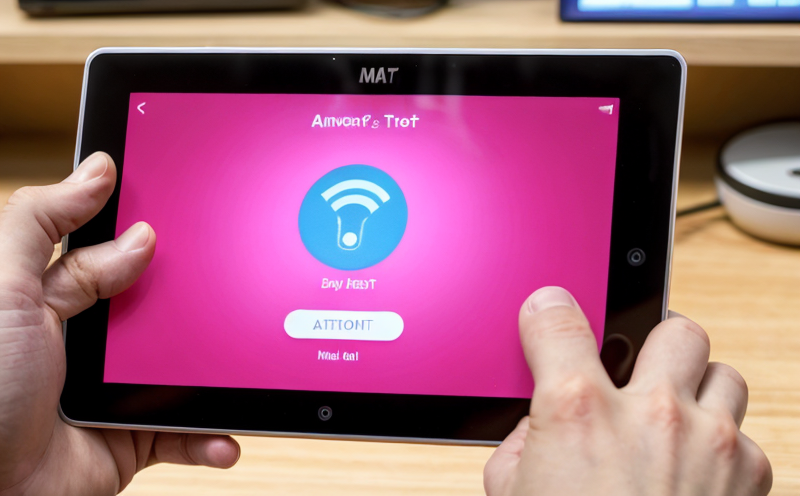Touchscreen Durability Testing of IoT Devices
In today’s fast-evolving world of smart and connected consumer devices (IoT), touchscreen technology has become an indispensable component. The seamless interaction between users and these devices is primarily facilitated through touchscreens, which are not only essential for user experience but also critical for the functionality and longevity of IoT products.
The durability of a touchscreen directly impacts the product’s performance over time, especially in environments where the device might be subjected to frequent handling or harsh conditions. This is particularly relevant for IoT devices such as smartwatches, home automation systems, wearable fitness trackers, and smart home appliances that are designed to be used both indoors and outdoors.
At Eurolab, we understand the importance of ensuring that touchscreens in IoT devices meet rigorous standards. Our touchscreen durability testing services are tailored to replicate real-world usage scenarios, providing a comprehensive assessment of how well these devices can withstand various environmental factors like humidity, temperature fluctuations, mechanical stress, and more.
Our testing process begins with the careful preparation of specimens according to industry best practices. This involves selecting appropriate test samples that closely represent the end-user experience for each specific IoT device type. Once prepared, we subject these devices to a series of tests designed to simulate everyday usage as well as extreme conditions.
One crucial aspect of our testing methodology is the use of specialized equipment capable of replicating diverse environmental stressors. For instance, we employ climate chambers that can control temperature and humidity levels within precise ranges, simulating different climatic zones around the globe. Additionally, vibration testers are used to mimic the effects of transportation or rough handling.
The testing process also includes mechanical strain tests which simulate user interactions such as tapping, scrolling, swiping, and even accidental drops. These tests help identify potential weaknesses in design that could lead to failures over time. By combining these various stressors into a single comprehensive test regime, we ensure that our clients receive accurate assessments of their product’s durability.
Upon completion of the testing cycle, detailed reports are generated providing insights into any issues encountered during the tests along with recommendations for improvements if necessary. These reports serve as valuable tools not only for compliance purposes but also for continuous improvement in design and manufacturing processes.
Understanding that every IoT device serves unique purposes across different sectors from healthcare to retail, our touchscreen durability testing services cater specifically to these diverse applications ensuring robust performance under all conditions expected by end-users globally.
Why It Matters
The durability of touchscreens in IoT devices is more than just a technical specification; it represents the reliability and longevity that consumers expect from their smart products. In sectors like healthcare where precision and functionality are paramount, or retail environments characterized by high traffic and varied user behaviors, robust touchscreen performance can significantly enhance user satisfaction while reducing maintenance costs.
From an environmental perspective, durable touchscreens contribute positively towards sustainability goals by extending the lifespan of devices and minimizing electronic waste. By ensuring that touchscreens perform optimally over extended periods without degradation due to wear and tear, manufacturers can design products with longer operational lifecycles which ultimately lead to reduced resource consumption during production.
Moreover, regulatory compliance plays a crucial role in this aspect as many regions have established standards governing the quality of components used in electronic devices. Compliance not only protects brand reputation but also ensures safe and efficient operation under intended conditions.
- Reduced Product Recall Costs: Durable touchscreens reduce instances where defective products need to be recalled, saving manufacturers significant amounts of money.
- Better Consumer Trust: Reliable performance fosters trust among consumers who value consistent quality in their purchases.
- Increased Product Lifespan: Robust touchscreens contribute to longer-lasting devices which are beneficial for both users and the environment.
Eurolab Advantages
At Eurolab, we pride ourselves on delivering high-quality testing services that go beyond basic compliance checks to provide actionable insights. Our team comprises experienced professionals who stay updated with the latest developments in touchscreen technology and regulatory requirements.
We offer a range of customization options allowing us to tailor our services specifically for your needs whether you require comprehensive durability assessments or targeted evaluations focusing on particular aspects like tactile feedback or response time.
Our advanced facilities equipped with state-of-the-art equipment ensure accurate results every time. We employ cutting-edge testing methodologies that closely mimic real-world conditions making sure that the tests conducted are both relevant and reliable.
In addition to our technical expertise, we also offer support throughout all stages of your project from initial consultation through final report delivery ensuring a smooth collaboration process. With Eurolab as your partner in touchscreen durability testing, you can rest assured knowing that your devices will meet the highest standards both locally and internationally.
Environmental and Sustainability Contributions
- Extended Product Lifespan: By ensuring that touchscreens in IoT devices are durable, we contribute to reducing electronic waste by extending the operational life of these products.
- Energy Efficiency: Durable touchscreens help reduce energy consumption as they require less frequent replacements leading to lower overall power usage over their lifetime.
- Resource Conservation: Longer-lasting devices mean reduced demand for raw materials during production, thus promoting efficient use of natural resources.





